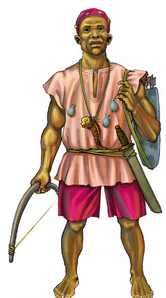
support@yorubalibrary.com
+2348073529208, 07038599574

Yoruba traditional clothing is an essential aspect of Yoruba culture, reflecting the people’s rich heritage, social status, and identity. From the intricate designs of past garments to the evolving styles of the present, Yoruba clothing continues to be a significant expression of cultural pride and artistic craftsmanship.
Historical Overview of Yoruba Traditional Clothing
Traditional Yoruba clothing has deep roots in history, with garments and textiles reflecting the community’s values, beliefs, and social structure. These clothes were often made from locally sourced materials, including cotton, silk, and various plant fibers, dyed and woven into beautiful patterns.
1. Materials and Fabrics
Aso-Oke: A handwoven cloth that has been a staple in Yoruba fashion for centuries. It comes in various types, such as Sanyan (woven from beige silk), Alaari (crimson silk), and Etu (dark blue cloth).
Adire: A resist-dyed cloth made using indigo. Adire patterns are created through tie-dyeing, folding, and stitching techniques.
2. Garments for Men
Agbada: A flowing, wide-sleeved robe worn over a tunic and trousers. Agbada is a symbol of prestige and is often worn during special occasions.
Buba and Sokoto: A traditional ensemble consisting of a loose-fitting top (Buba) and matching trousers (Sokoto). This outfit is suitable for both everyday wear and formal events.
Fila: A traditional cap that completes the Yoruba male attire. Filas come in various styles, such as the Abeti Aja (dog ear cap) and Gobi.
3. Garments for Women
Iro and Buba: A wrap skirt (Iro) paired with a loose blouse (Buba). This combination is commonly worn by Yoruba women.
Gele: An intricately tied head-wrap that adds elegance and distinction to a woman’s outfit.
Ipele: A matching shawl or shoulder sash that complements the Iro and Buba, often used during formal events or ceremonies.
Symbolism and Cultural Significance
Yoruba clothing is more than just attire; it carries significant cultural symbolism. Each garment and accessory often represents social status, marital status, and ethnic identity. Specific patterns and colors in textiles can denote particular meanings, such as wealth, fertility, or spiritual protection.
1. Colors and Patterns
White: Symbolizes purity and peace, often worn during religious ceremonies.
Red: Represents power and vitality, used in garments for warriors and leaders.
Blue and Indigo: Associated with tranquility and the spiritual world, frequently seen in Adire fabrics.
2. Occasions and Festivals
Weddings and Celebrations: Elaborate Aso-Oke and richly patterned garments are worn to celebrate weddings and other joyful events.
Religious Ceremonies: Specific garments are chosen to honor deities and partake in traditional rituals.
Evolution and Modern Adaptations
As Yoruba culture has evolved, so too has its traditional clothing. Modern influences and global fashion trends have led to new interpretations and styles that blend traditional elements with contemporary aesthetics.
1. Contemporary Designs
Fusion Fashion: Designers are creating pieces that merge traditional Yoruba fabrics and patterns with modern silhouettes and styles, appealing to a younger generation.
Ready-to-Wear Collections: Modern adaptations of traditional garments are now available in ready-to-wear collections, making Yoruba fashion more accessible.
2. Urban Influence
Street Style: Yoruba traditional clothing has influenced urban fashion, with elements like Adire and Aso-Oke appearing in streetwear and casual attire.
Celebrity Endorsements: Nigerian and international celebrities donning Yoruba attire have helped popularize these garments on a global scale.
3. Sustainable Practices
Eco-Friendly Textiles: There is a growing trend towards using sustainable and eco-friendly materials in traditional Yoruba clothing, preserving artisanal techniques while promoting environmental consciousness.
Preservation and Promotion of Yoruba Clothing
Efforts to preserve and promote Yoruba traditional clothing include:
1. Cultural Festivals and Fashion Shows
Aso-Oke Day: Celebrations dedicated to Aso-Oke, where people showcase their finest garments.
Lagos Fashion Week: An event that highlights Yoruba traditional fashion alongside contemporary African designs.
2. Educational Programs and Workshops
Textile Weaving and Dyeing Workshops: Programs that teach the younger generation the skills and techniques involved in creating traditional Yoruba textiles.
Fashion Design Schools: Institutions that incorporate Yoruba traditional clothing into their curriculum, ensuring the transmission of knowledge and skills.
3. Artisanal Cooperatives
Community Support: Cooperatives that support local artisans and weavers, helping them sustain their craft and reach broader markets.
Conclusion
Yoruba traditional clothing is a vibrant and enduring aspect of Yoruba culture, symbolizing identity, heritage, and artistic expression. From the timeless elegance of historical garments to the innovative designs of the present, Yoruba clothing continues to captivate and inspire. By preserving these traditions and embracing modern adaptations, the Yoruba people ensure that their cultural legacy remains dynamic and relevant.

Learn about the Yoruba concept of Ìwà Pẹ̀lẹ́ (good…

Learn special praises for Divine Being and Creator…